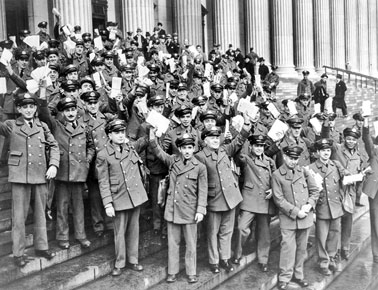First Social Security check: Jan. 31, 1940

Postal carriers delivering SS-5 application forms on the first day of the SSN enumeration effort. SSA History Museum & Archives.
A former Vermont legal secretary named Ida May Fuller becomes the first person to receive a monthly Social Security check from the U.S. government. That first check, stamped with the number 00-000-001, was for $22.54–or about $350 today.
In the three years prior to her retirement, the woman known to friends as “Aunt Ida,” had paid a total of $24.75 in Social Security taxes. Only five years earlier, during one of the worst years of the Great Depression, President Franklin Roosevelt had signed the Social Security Act, designed to provide continuing income for retired people.
As with the Affordable Care Act, the Social Security Act’s rollout had been anything but smooth. The newly created Social Security Board had faced the daunting task of enrolling 26 million workers in less than a year—without the benefit of computers. To complicate matters, many Americans had the same name. The agency brought in a management expert for advice, but after several months of research, he concluded that the federal government would be incapable of running the program.
But the board persevered and turned to another government agency that ended up saving the day—the U.S. Postal Service. Letter carriers delivered applications for Social Security numbers, helped people fill out the forms, answered questions, returned the forms to typing centers where Social Security cards were produced, and then delivered the new cards to people’s mailboxes. Read more
The registration process was largely directed by the local postmasters. The first task was for mail carriers to make lists of employers on their routes. Their effort resulted in a list of 2.4 million employers. Beginning November 16, 1936, the post offices sent Form SS-4, Application for an EIN, to employers based on the lists they had compiled earlier that month. Along with information about the business establishment, the SS-4 asked for the number of workers employed. The mail carriers collected the completed SS-4s a week or two later. Based on the SS-4 information, the post offices delivered a supply of Forms SS-5, Application for an Account Number, to the employers the following week for distribution to employees.
Employees were permitted to return the completed SS-5 applications either to the employer, to any labor organization of which the employee was a member, to the letter carrier, or to the post office by hand or via mail. Of the 45,000 post offices then in existence, 1,017 first class offices were designated as “typing centers” to assign the SSNs, along with 57 “central accounting” post offices to assign SSNs for the second, third, and fourth class post offices within their area . The Social Security Board supplied these centers with Office Record Form OA-702, in blocks of 1,000, with the account number preprinted. For each registrant, postal employees typed the information from the SS-5 onto the prenumbered OA-702 in duplicate. The employee’s name was typed onto a detachable portion of the OA-702, which was then returned to the employee—this was the Social Security card. The post office mailed the completed Social Security cards to the employer, unless the employee had brought the SS-5 to the post office and waited in person for the typed card.
Read more from the Social Security Administration
Water carrying for the Leftist regime again, eh? Wait till they start taxing our “Cadillac” health care plans to pay for our new illegal alien “citizens.”